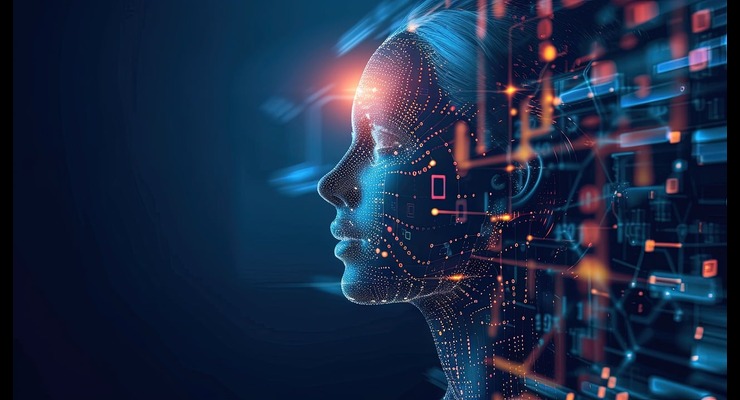The global artificial intelligence (AI) landscape is undergoing a profound transformation, and India is positioning itself as a key player through the IndiaAI mission. Launched on March 6 by the Ministry of Electronics and Information Technology, this initiative is a strategic response to the rapid advancements in AI technologies worldwide, such as generative models like ChatGPT, and the growing need for technological self-reliance. With an approved budget of ₹10,371.92 crore from the Union Cabinet in March 2023, the IndiaAI mission, developed in collaboration with Nasscom, aims to create a robust ecosystem for indigenous AI development. The mission is built on the dual pillars of "Making AI in India and Making AI Work for India," focusing on fostering local innovation while addressing India-specific challenges. In this detailed blog post, we will explore the mission’s objectives, the motivations driving Indian firms to prioritize local AI, the economic and societal impacts, future prospects, challenges, and India’s strategic responses. Additionally, we’ll connect this initiative to broader economic contexts, such as tariffs and inflation, and examine India’s role in the global tech landscape.
The IndiaAI Mission: A Comprehensive Overview
The IndiaAI mission is a collaborative effort between the Ministry of Electronics and Information Technology and Nasscom, India’s leading tech industry association. It was conceptualized in 2023 amid a global surge in AI adoption, particularly after the success of generative AI models that demonstrated the transformative potential of this technology. The Union Cabinet’s approval of ₹10,371.92 crore underscores the government’s commitment to positioning India as a global AI leader. The mission is structured around several key components that aim to create a self-sustaining AI ecosystem:
Key Objectives and Components
- Development of India-Specific AI Models: The mission emphasizes creating AI solutions that cater to India’s unique needs, such as models that support the country’s 22 official languages, including Hindi, Tamil, Bengali, and Telugu. This focus ensures that AI tools are accessible to India’s diverse population, addressing regional challenges in sectors like education, healthcare, and agriculture.
- Common Compute Platform (CCP): The CCP is a cornerstone of the mission, providing developers with access to high-performance computing resources, including Graphics Processing Units (GPUs) and cloud infrastructure. With an investment of ₹10,000 crore, the CCP aims to democratize access to compute power, enabling startups, researchers, and enterprises to build and scale AI models without the prohibitive costs of private infrastructure.
- Data Accessibility and Research Support: The mission facilitates the use of vast, India-specific datasets, such as those related to agriculture, healthcare, and linguistic diversity, to fuel AI innovation. It also fosters a collaborative network of researchers, academic institutions, and industry players to drive cutting-edge research and development.
- Skill Development and Ecosystem Building: Beyond infrastructure, the mission includes initiatives to train AI professionals, support startups, and promote public-private partnerships, ensuring a holistic approach to ecosystem development.
The IndiaAI mission is not just a technological endeavor but a strategic move to enhance India’s global competitiveness, reduce dependency on foreign tech, and address local socio-economic challenges.
Why Are Indian Firms Racing to Build Local AI? A Detailed Exploration
The urgency for Indian firms to develop local AI is driven by a combination of strategic, economic, and socio-cultural factors, each of which has far-reaching implications:
1. Global Competition and Technological Sovereignty
The global AI landscape is dominated by the United States and China, with companies like OpenAI, Google, and Baidu leading the charge. These nations have invested heavily in AI, leveraging their technological prowess to set global standards. For India, this creates a dual challenge: competing with these giants while ensuring technological sovereignty. By developing local AI, India can reduce its reliance on foreign platforms, which often come with data privacy concerns and high licensing costs. For instance, many foreign AI models do not support Indian languages or address local challenges like rural healthcare delivery, making indigenous solutions a necessity. Additionally, data sovereignty is a critical concern—local AI ensures that sensitive data, such as health records or financial information, remains within India’s jurisdiction, aligning with national security and privacy priorities.
2. Economic Imperatives and Growth Opportunities
AI has the potential to be a game-changer for India’s economy, which is already the world’s fifth-largest, with a GDP of $3.94 trillion in 2023. The technology can drive growth across multiple sectors, from IT services to agriculture. For instance, AI-powered tools can optimize crop yields for farmers, improve supply chain efficiency for manufacturers, and enhance customer experiences in retail. Nasscom estimates that AI could contribute $957 billion to India’s economy by 2035, provided the ecosystem matures effectively. This economic potential has spurred Indian firms to act swiftly, as they see AI as a means to boost productivity, create jobs, and increase exports. The IT services sector, which contributed $194 billion in exports in 2023, could see a significant boost if India develops AI solutions that can be exported globally, such as multilingual chatbots or AI-driven cybersecurity tools.
3. Addressing India-Specific Challenges
India’s diversity—over 1.4 billion people, 22 official languages, and a mix of urban and rural economies—presents unique challenges that foreign AI models often fail to address. For example, a healthcare AI model developed in the US might not account for India’s high prevalence of tropical diseases like dengue or the lack of medical infrastructure in rural areas. Similarly, educational AI tools need to support languages like Marathi or Kannada to reach students in non-English-speaking regions. The IndiaAI mission tackles these gaps by encouraging the development of AI models that are contextually relevant, such as speech recognition systems for Indian languages or predictive analytics for monsoon-dependent agriculture. This focus on local needs ensures that AI delivers tangible benefits to India’s population, from farmers in Punjab to students in Kerala.
4. Government Support and Policy Alignment
The Indian government has created a favorable environment for AI development through substantial investments and policy support. The ₹10,371.92 crore budget for the IndiaAI mission, coupled with the ₹10,000 crore allocation for the CCP, demonstrates a clear commitment to fostering innovation. Additionally, the mission aligns with broader initiatives like "Make in India" and the Production Linked Incentive (PLI) scheme, which aim to boost domestic manufacturing and reduce import dependency. Tax incentives, grants, and startup incubators further encourage private-sector participation, with major firms like TCS, Infosys, and Wipro joining the race alongside hundreds of AI startups. The government’s proactive stance has created a sense of urgency among firms, as they recognize the opportunity to leverage public resources to gain a competitive edge.
Impact on India’s Economy, Society, and Global Standing: A Deep Dive
The IndiaAI mission has the potential to transform India across multiple dimensions, from economic growth to social inclusion and international collaboration. Let’s break down these impacts in detail:
1. Economic Transformation: Jobs, Exports, and GDP Growth
The mission is poised to catalyze a tech-driven economic revolution in India, with far-reaching effects on employment, exports, and overall GDP:
- Job Creation Across Tiers: AI development requires a diverse workforce, including data scientists, machine learning engineers, software developers, and data annotators. The mission could generate millions of jobs, particularly in tier-2 and tier-3 cities like Coimbatore, Jaipur, and Bhubaneswar, where tech talent is increasingly being tapped. For instance, data annotation jobs, which are labor-intensive, can provide employment opportunities for semi-skilled workers in smaller towns, reducing urban-rural disparities.
- Boost to Exports and Global Competitiveness: India’s IT services sector, already a global leader with $194 billion in exports in 2023, stands to gain significantly from local AI development. Indigenous AI solutions, such as multilingual translation tools, AI-driven cybersecurity software, or predictive maintenance systems for manufacturing, could become exportable products. This would not only increase India’s share of the global tech market but also diversify its export portfolio beyond traditional IT services.
- Contribution to GDP: Nasscom’s projection of a $957 billion contribution to India’s economy by 2035 highlights AI’s transformative potential. This growth will come from increased productivity, new business models, and the expansion of tech-driven sectors like e-commerce, fintech, and agritech. For example, AI-powered supply chain optimization could save billions for Indian manufacturers, while AI-driven fintech solutions could enhance financial inclusion for millions of unbanked citizens.
2. Societal Benefits: Bridging Gaps and Promoting Inclusion
The IndiaAI mission goes beyond economics, aiming to address deep-rooted social challenges and promote inclusivity:
- Education and Skill Development: AI-driven personalized learning platforms can revolutionize education in India, where access to quality education remains uneven. For instance, an AI tutor that speaks Telugu or Assamese can help students in rural areas learn at their own pace, while adaptive learning algorithms can identify and address individual learning gaps. This could significantly improve educational outcomes, particularly for the 260 million students enrolled in India’s school system.
- Healthcare Accessibility: In a country where rural healthcare infrastructure is limited, AI can play a pivotal role. AI-powered diagnostic tools can help doctors in remote areas diagnose diseases like tuberculosis or diabetes with greater accuracy, while telemedicine platforms can connect patients with specialists in urban centers. For example, an AI model trained on Indian health data could predict outbreaks of diseases like dengue, enabling timely interventions.
- Digital Inclusion Through Language Diversity: India’s linguistic diversity—22 official languages and hundreds of dialects—has long been a barrier to digital adoption. The IndiaAI mission addresses this by prioritizing AI models that support regional languages. Speech recognition systems, chatbots, and virtual assistants in languages like Hindi, Tamil, or Bengali can empower rural populations to access digital services, from online banking to e-governance platforms, bridging the digital divide.
- Sustainability and Climate Resilience: AI applications in smart agriculture, such as predictive analytics for crop yields or weather forecasting, can help farmers adapt to climate change. Similarly, AI-driven energy management systems can optimize India’s renewable energy grid, supporting the country’s net-zero emissions goal by 2070. These initiatives align with global sustainability trends, positioning India as a leader in green technology.
3. Strengthening India’s Global Standing and Tech Collaborations
The IndiaAI mission enhances India’s role in the global tech ecosystem, fostering collaboration while asserting its independence:
- Deepening India-US Tech Ties: India and the US have a strong tech partnership, with collaborations in areas like semiconductor manufacturing and cybersecurity. The IndiaAI mission could further strengthen this relationship by fostering joint AI research and development. For instance, Indian firms could partner with US companies to develop AI models for global markets, leveraging India’s talent pool and the US’s technological infrastructure. However, this collaboration must navigate challenges like the US tariffs discussed earlier, which could raise costs for Indian tech exports.
- Countering China’s AI Dominance: China’s heavy investments in AI, supported by government-backed firms like Baidu and Alibaba, have made it a global leader. India’s local AI push positions it as a democratic alternative, appealing to nations wary of China’s influence. By offering ethical, transparent AI solutions, India can attract partnerships with countries in the EU, ASEAN, and Africa.
- Shaping Global AI Governance: As AI becomes integral to economies worldwide, ethical and regulatory concerns—like bias, privacy, and accountability—are gaining prominence. India can play a leading role in shaping global AI governance by advocating for inclusive standards that reflect the needs of developing nations. Joining initiatives like the Global Partnership on AI (GPAI) could amplify India’s voice on the world stage.
4. Implications for the Middle Class and Workforce
While the IndiaAI mission promises significant benefits, it also poses challenges for India’s middle class and workforce:
- Job Displacement Risks: The automation potential of AI could disrupt traditional jobs in sectors like manufacturing, retail, and customer service. For example, AI-driven chatbots might replace call center roles, a key employment source for India’s middle class. This could lead to short-term job losses, requiring reskilling programs to transition workers into tech-driven roles.
- Economic Opportunities: On the flip side, the mission creates new opportunities for the middle class, particularly in tech hubs like Bengaluru, Hyderabad, and Pune. Roles in AI development, data analysis, and cybersecurity are on the rise, offering higher salaries and career growth. Additionally, AI-driven cost savings in sectors like healthcare and education could reduce financial burdens for middle-class families.
Future Aspects: Opportunities, Risks, and Long-Term Vision
The IndiaAI mission sets the stage for a transformative future, but its success depends on navigating a complex landscape of opportunities and risks:
Opportunities
- Establishing India as a Global AI Hub: With scalable infrastructure like the CCP, India could rival global tech hubs like Silicon Valley or Shenzhen. By attracting foreign investment and talent, India can become a go-to destination for AI innovation, similar to how it became a leader in IT services.
- Fostering a Thriving Innovation Ecosystem: The mission encourages startups to focus on niche areas, such as AI for climate modeling, multilingual education tools, or predictive healthcare analytics. For instance, a startup developing AI to optimize solar energy grids could attract global attention, given the rising demand for sustainable tech.
- Enhancing Policy Leadership: India has an opportunity to lead global AI policy discussions, particularly on ethical AI and data privacy. By advocating for standards that prioritize inclusivity and fairness, India can influence how AI is developed and deployed worldwide, especially in the Global South.
- Export Potential and Market Expansion: Indigenous AI solutions have significant export potential. For example, an AI model that supports multilingual customer service could be adopted by businesses in Africa or Southeast Asia, regions with similar linguistic diversity. This could add billions to India’s tech exports, which are already a cornerstone of its economy.
Risks
- Infrastructure Bottlenecks and Compute Limitations: Despite the ₹10,000 crore investment in the CCP, scaling GPU availability remains a challenge. High-performance computing is expensive, and India currently lags behind the US and China in terms of compute infrastructure. Without rapid expansion, developers may face bottlenecks, slowing innovation.
- Skill Gap and Talent Shortage: Nasscom estimates a shortage of 1.2 million AI professionals by 2026, a significant barrier to the mission’s success. While India produces millions of STEM graduates annually, many lack specialized AI skills like deep learning or natural language processing. Bridging this gap requires substantial investment in education and training.
- Geopolitical Tensions and Trade Barriers: The tariff fallout discussed earlier highlights the risks of geopolitical tensions. If trade disputes with the US or EU escalate, India’s access to global datasets, hardware (like GPUs), and collaborative opportunities could be restricted, hampering AI development.
- Ethical and Regulatory Challenges: AI raises concerns about bias, privacy, and accountability. For instance, an AI model trained on biased data could perpetuate inequalities in healthcare or hiring. India must establish robust regulatory frameworks to address these issues, ensuring that AI development aligns with ethical principles.
India’s Counter-Reaction: Strategic Mitigation Measures
To ensure the IndiaAI mission’s success, India must adopt a comprehensive, multi-pronged strategy:
-
Education and Workforce Development:
- Launch nationwide AI bootcamps and online courses in partnership with platforms like Coursera and edX to train professionals in machine learning, data science, and AI ethics.
- Integrate AI into school and university curricula, focusing on practical skills like coding and data analysis. For example, introducing Python programming in high schools can prepare students for AI careers.
- Collaborate with global tech firms like Google, Microsoft, and IBM to offer certifications and mentorship programs, ensuring that Indian talent meets international standards.
-
Infrastructure Expansion and Accessibility:
- Increase GPU deployment by incentivizing private-sector investment in data centers. For instance, offering tax breaks to companies that build regional compute hubs can accelerate infrastructure growth.
- Develop a network of regional data centers in cities like Chennai, Kolkata, and Ahmedabad to reduce latency and costs for developers in non-metro areas.
- Explore open-source cloud computing solutions to provide affordable access to compute resources for startups and small businesses.
-
Fostering International Collaboration:
- Negotiate bilateral data-sharing agreements with the US, EU, and Japan to access global datasets while ensuring data privacy. For example, partnering with the US on healthcare AI research can benefit both nations.
- Join international AI alliances like the Global Partnership on AI (GPAI) to influence global standards and gain access to best practices.
- Host global AI summits in India to attract investment and showcase indigenous innovations, positioning India as a collaborative partner.
-
Incentivizing Innovation and Startup Growth:
- Offer tax holidays and seed funding for AI startups, particularly those focusing on underserved sectors like agriculture and education. For instance, a startup developing AI for soil health analysis could receive government grants to scale its operations.
- Expand the PLI scheme to include AI hardware manufacturing, encouraging companies to produce GPUs and other components domestically.
- Create AI innovation hubs in tech clusters like Bengaluru and Hyderabad, providing startups with mentorship, funding, and access to the CCP.
-
Building a Robust Regulatory Framework:
- Establish a national AI policy that addresses ethical concerns, such as algorithmic bias and data privacy, ensuring that AI development aligns with India’s constitutional values.
- Create an AI regulatory body to oversee compliance, monitor AI applications, and address public grievances. This body could also collaborate with international regulators to harmonize standards.
- Promote transparency by requiring companies to disclose how their AI models are trained and used, building public trust in the technology.
Connection to Tariffs, Inflation, and Middle-Class Dynamics
The IndiaAI mission intersects with the tariff fallout discussed previously, creating both opportunities and challenges:
- Mitigating Tariff Impacts: US tariffs on Indian tech exports, as highlighted earlier, could raise costs for firms reliant on American markets. However, local AI development reduces India’s dependence on imported tech, mitigating some of these effects. For instance, if India produces its own AI software for cybersecurity, it can bypass tariff-related cost increases on US imports.
- Inflation and Cost Pressures: The projected inflation spike to 7% (due to tariff-induced trade disruptions) could increase the cost of AI hardware, such as GPUs, which are often imported. This would strain budgets for startups and researchers, potentially slowing innovation. The middle class, already grappling with rising prices for essentials, may face additional financial pressure if AI development costs are passed on to consumers.
- Middle-Class Benefits and Risks: AI-driven cost savings in healthcare (e.g., affordable diagnostics) and education (e.g., free AI tutors) could alleviate some financial burdens for the middle class. However, job displacement in export-dependent sectors like IT services, exacerbated by tariffs, could offset these gains. Reskilling programs will be crucial to ensure the middle class can transition into AI-driven roles.
Conclusion: India’s AI Journey and Global Ambitions
The IndiaAI mission is a visionary step toward technological sovereignty, economic empowerment, and global leadership. By fostering local AI development, India addresses its unique challenges—linguistic diversity, rural healthcare, and agricultural productivity—while positioning itself as a democratic alternative to China’s AI dominance. The mission’s success could add $957 billion to India’s economy by 2035, create millions of jobs, and enhance digital inclusion for its 1.4 billion citizens. However, challenges like infrastructure gaps, skill shortages, and geopolitical tensions must be addressed through strategic investments, education reform, and international collaboration. As Indian firms race to build local AI, the mission’s impact will reverberate globally, shaping the future of technology and innovation. What role do you think India will play in the global AI landscape? Share your thoughts below!

 Sangram Keshari
Sangram Keshari









